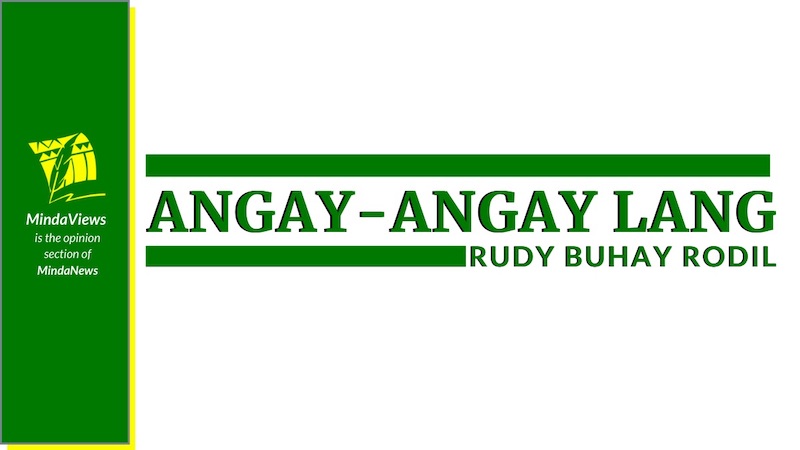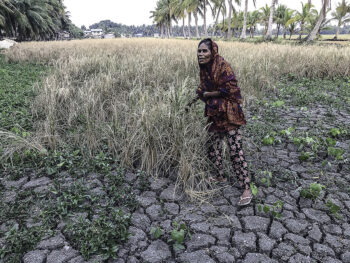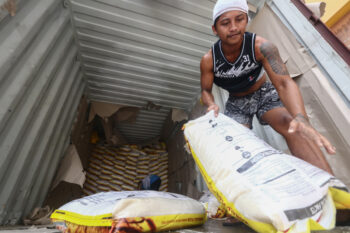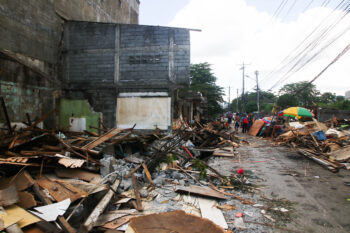
Last of two parts
Sensitive Issues in the Negotiations
Focus on three aspects: the problem of territory, for whom is autonomy, and why autonomy?
Territory. At the very start of the first round of negotiations, the talks bogged down owing, allegedly, to the demands of the MNLF for complete independence for the Bangsa Moro Republic in the entirety of Mindanao, Basilan, the Archipelago of Sulu and Palawan. This may be regarded as a big failure. It can also be viewed as a success in that it broke the ice for further exchange between the two contending parties which in the past communicated only through the barrel of the gun. For lack of details, however, we are unable to put together a clearer picture of this particular negotiation.
What is clear from the manifestations of the MNLF is that the organization considers the Bangsa Moro as a nation and that it is composed of the indigenous Muslims in the region , the native peoples who now refer to themselves as Lumad, the indigenous Christians, and those from the settler or migrant category who sympathize with the basic aspirations of the Bangsa Moro. Its traditional territory or homeland is the entirety of Mindanao, Basilan, the Sulu Archipelago and Palawan.
This particular issue is a lot clearer in the Tripoli agreement. The document specifies that the autonomy is for the Muslim inhabitants of southern Philippines, that this shall be within the territorial integrity and the national sovereignty of the country.
A listing is made of the places that shall constitute the territory of the autonomy, the thirteen provinces of Basilan, Sulu, Tawi-Tawi, Zamboanga del Sur, Zamboanga del Norte, North Cotabato, Maguindanao, Sultan Kudarat, Lanao del Norte, Lanao del Sur, Davao del Sur, South Cotabato, Palawan and all the cities and towns within said places.
The last provision which is directly related to the issue of territory specifies that the government of the Philippines shall take the necessary constitutional processes in the implementation of the agreement. Which means there shall be a plebiscite within said territory to determine which among them would be willing to be part of the autonomy.
We all know that there was indeed a plebiscite as a consequence of which Davao del Sur, South Cotabato and Palawan were stricken from the 13, and the remaining ten provinces were in turn subdivided into five each for Regions IX and XII.
In the third negotiation, the problem of territory re-emerged. It was agreed on in Jeddah that the two parties would continue to discuss the grant of full autonomy to Mindanao, Basilan, the Archipelago of Sulu and Palawan, or a total of 23 provinces, if viewed within the present political set up. The talks focused on how to treat these 23 provinces. There is no need to go into details because nothing happened to the third negotiation anyway. The ratification of the 1987 Constitution caught up with it.
Some questions must be asked at this point. In the first and third negotiation, what was the basis for claiming the entirety of Mindanao, Basilan, the Sulu archipelago and Palawan? In the second negotiation, what was the basis for agreement on the thirteen provinces?
What is the position of the government panel with respect to the territorial question?
From scattered data which we have been able to put together, it appears that the initial position of the panel headed by Undersecretary Carmelo Barbero was confined to the jurisdiction of Regions IX and XII, or a total of ten provinces.
And the initial stand of the MNLF was the same one of the entirety of Mindanao, Basilan, Sulu archipelago and Palawan.
To simplify matters, Dr. Treki requested both panels to submit their respective positions and the basis for the same. The stand of the government was contained in Inc.4 entitled RP Position Paper. We have not seen this document.
At the resumption of the session the following day, Dr. Treki said that the Quadripartite Ministerial Commission had decided that MINSUPALA be the territory of the autonomy.
Mr. Barbero’s group replied that it would be in the interest of the Filipino Muslims to have two autonomous regions. The Muslims constitute the majority population in a number of provinces in Regions IX and XII, and if MINSUPALA were to become the autonomous region it would be meaningless because they are the minority here. It must be borne in mind that the autonomy is being created purposely for them.
The refusal of the RP Panel to agree to the decision of the Quadripartite Commission provoked the first threat of Dr. Treki already mentioned earlier. Later, the MNLF suggested the addition of Davao del Sur, South Cotabato and Palawan to the ten, and this was accepted by the RP Panel, that is, after obtaining prior approval from Malacañang, provided that it would be subject to Constitutional processes.
The revival of the original MNLF position in the third negotiation did not come as a surprise. What is difficult to believe is the absence of a clear stand on the part of the Pelaez panel. [Please see Aide Memoire on the Peace Talks. Position of the Philippine Government Panel (Manila: Philippine Information Agency, May 1987].
A similar phenomenon may be discerned in the Constitutional Commission where the only basis of territory was “Muslim Mindanao” which, incidentally, carries as many as nine interpretations, each one with a corresponding territory of its own.
The Pelaez panel has already given two interpretations. First, the five provinces of Lanao del Sur, Maguindanao, Sulu, Basilan and Tawi-Tawi where the Muslims are the majority. Second, the ten provinces within the jurisdiction of Region IX and Region XII, as provided for in P.D. 1618. What are the other meanings?
Third, the 23 provinces encompassed within the Bangsa Moro Ancestral Homeland as expounded by the MNLF.
Fourth, 16 provinces or those within whose territories the Muslims have traditionally lived. Simply add Davao Oriental, Davao del Norte, Davao City and Bukidnon to those enumerated in the Tripoli agreement.
Fifth, 14 provinces or those covered within the Moro Province of the American period consisting of Davao, Cotabato, Lanao, Zamboanga, Sulu.
Sixth, those mentioned by the Mindanao Independence Movement in its 1968 manifesto as places within which Muslims live, or those falling within their sphere of influence, as follows: Cotabato, Davao, Zamboanga, Zamboanga City, Basilan City, Lanao, Sulu, Palawan, including adjacent places and islands, and the seas therein.
Seventh, the 13 provinces listed in the Tripoli agreement.
Eighth, the 13 provinces and nine cities, more or less, as provided for in RA 6649 or the law which created the Regional Consultative Commission for Muslim Mindanao.
Ninth, that which is provided for in the 1987 Constitution as dependent on the result of the plebiscite to be called to determine which of the thirteen provinces and nine cities would want to be included in the autonomous region for Muslim Mindanao. Theoretically, this territory was reducible from thirteen to zero. Now, we know that this means four provinces.
What lessons can we get out of this?
Until today, no in-depth study has ever been made either by the government, or by the different panels which got involved in the negotiations. The lack of consistency in the government stand leads us to assume inadequate knowledge on the part of government or points to the prevailing view in government with respect to the so-called Mindanao problem which is felt but not easily grasped.
I am of the opinion that if the government had only done its homework on this particular subject, a lot of issues could have been placed in their proper perspective.
Autonomy For Whom? At first glance, the autonomous region is for the Muslim Filipinos. But if we take a closer look at the progress of the talks, this does not seem to be the case.
Note that all the talks were bilateral. Only the government and the MNLF panels were involved.
I would like to mention here that at the time of the Tripoli negotiations, the core of the reactions from the non-Muslim segments of the Mindanao population was that it was their life that was being discussed, yet the government had not bothered to ask them.
It was only at the time of the third negotiation that the MNLF had a non-Muslim in its panel, and there was talk of their representation in, say, the legislative and the judiciary. Still, how come there was no specific mention of the other inhabitants of the autonomous region? How many Lumad tribes, for instance, are indigenous here? What is the size of their population? How many indigenous Christians are living in the region? How many new Christians are living in the region?
It seems the talks did not include such details. The only reference to them are the occasional mention with respect to the Muslims being 25% of the total population of Mindanao. Nothing more.
If we put the matter within the perspective of public administration, the Tripoli agreement might emerge as an example of class legislation instead of a simple special law. The situation would be bigger if we consider the devolution of political authority to the autonomous region. It would come out that one part of society is granted political power while another part is not. Or given, but only a little.
But although the non-Muslim segments of the population have not been involved in the bilateral talks, there is nevertheless the matter of the plebiscite, worded in the Tripoli agreement as follows: “The Government of the Philippines shall take all necessary constitutional processes for the implementation of the entire agreement”.
The same process is demanded in the 1987 Constitution.
As experience has shown, this process has had a self-destruct effect upon the noble intentions for providing autonomy. Which brings us to the next section of our discussion.
Why Autonomous Region? The subject first came up during the Tripoli negotiation. This was one of the four guidelines for the talks.
Did the government panel conduct preliminary studies on the subject prior to the negotiation? I do not know for sure.
What I know is that the government did not have any other policy on the minorities except that provided for in R.A. 1888 which created the Commission on National Integration, and it was the object of this law to assimilate the minority into the majority.
There was no provision on autonomy, nor has there been any such policy since. The 1987 Constitution provided for the creation of regional autonomy solely for the Cordillera and for Muslim Mindanao, nowhere else, as if they alone among the indigenous cultural communities were in need of autonomy.
I am raising the question because there seems to be an assumption that this autonomous region was the most appropriate arrangement for our Muslim brothers.
And yet the establishment of autonomy is made subject to a plebiscite wherein citizens who are not in need of autonomy are given the right to decide whether their place, municipality, city or province ought to be included in the autonomy.
Let us look, for example, at the problem of territory. From the original 23 provinces claimed by the MNLF, it became 13 in the Tripoli agreement. As a result of the plebiscite called by President Marcos on April 17, 1977, the single autonomous region became the two regions of IX and XII, with each consisting of five provinces.
In the third negotiation, it seems obvious enough that Ambassador Pelaez merely reacted to the position of the MNLF. The issue of territory kept changing.
True, the Pelaez panel took official notice of the shift in the MNLF position, yet it agreed to discuss the proposal anyway. And now, only four provinces constitute the autonomous region.
What will become of the other Muslims who cannot be part of autonomy even if they genuinely desire to be so for the simple reason that they do not have the number to win in their place of residence? Almost all the Lumad communities find themselves in exactly the same predicament.
It may be necessary to rethink the basic assumptions of our constitutional or political processes with respect to the creation of political units.
It may have struck some of us that the creation of an autonomous region, or even of local autonomy (which has no precedence yet in the history of the country) for Indigenous Cultural Communities (ICC) does not fall in the same league as the establishment of a local political unit which requires a plebiscite as a must where all citizens affected have the inherent right to vote or take part in the decision-making.
It must be stressed that autonomy for the ICCs is a special political arrangement that calls for a special measure.
From a historical perspective we cannot ignore the basic reality that there exist substantial groups of people that are in need of autonomy because they are culturally distinct from the greater majority.
This is hard evidence that we are very much a country-in-formation and, therefore, must open to new political concepts and possibilities. For the moment, it seems obvious enough that our present Constitution cannot give full satisfaction to the historic right of the Indigenous Cultural Communities for autonomous political existence.
Conclusion
The government should put together an integrated policy and program for the minorities, or for the Indigenous Cultural Communities. If giving them autonomy is the most appropriate arrangement for them, then let them have autonomy, all of them, not just segments of them, differing only on whether it should be regional or local autonomy. The latter may be provincial, municipal or barangay as the case may be.
But before the matter is put into law, there ought to be an in-depth study of the problem, including the possibility of negotiations, or at least consultations in the local level to ensure the appropriateness of the program.
Any autonomy that is created should not be made subject to a plebiscite, where even those who have absolutely no need for autonomy are given the right to decide on the matter. (MindaViews is the opinion section of MindaNews. A peace specialist, Rudy Buhay Rodil is an active Mindanao historian and peace advocate)







